Facile Construction of Bio-Based Supramolecular Hydrogels from Dehydroabietic Acid with a Tricyclic Hydrophenanthrene Skeleton and Stabilized Gel Emulsions
Abstract
:1. Introduction
2. Results and Discussion
2.1. Phase Behavior of Supramolecular Hydrogels
2.2. DSC Analysis of the Supramolecular Gels
2.3. Rheological Properties of the Supramolecular Gels
2.4. Cryo-TEM of Supramolecular Hydrogel
2.5. The CD Spectrum of the Supramolecular Hydrogel
2.6. The Gelation Mechanism of Supramolecular Hydrogels
2.7. Preparation of the Supramolecular Gel Emulsions
2.8. CLSM of the Supramolecular Gel Emulsion
3. Materials and Methods
3.1. Materials
3.2. Preparation of Rosin-Based Ammonium Salts
3.3. Preparation of Gel Emulsions
3.4. Rheological Measurements
3.5. Determination of the Gelation Temperature of Hydrogels
3.6. Small-Angle X-ray Scattering (SAXS)
3.7. Cryogenic Transmission Electron Microscopy (cryo-TEM)
3.8. Circular Dichroism Spectroscopy (CD)
3.9. Confocal Laser Scanning Microscopy (CLSM)
4. Conclusions
Supplementary Materials
Author Contributions
Funding
Institutional Review Board Statement
Informed Consent Statement
Data Availability Statement
Conflicts of Interest
Sample Availability
References
- Yan, T.; Song, B.; Pei, X.; Cui, Z.; Binks, B.P.; Yang, H. Widely Adaptable Oil-in-Water Gel Emulsions Stabilized by an Amphiphilic Hydrogelator Derived from Dehydroabietic Acid. Angew. Chem. Int. Ed. 2020, 59, 637–641. [Google Scholar] [CrossRef]
- Zhang, M.; Strandman, S.; Waldron, K.C.; Zhu, X.X. Supramolecular hydrogelation with bile acid derivatives: Structures, properties and applications. J. Mater. Chem. B 2016, 4, 7506–7520. [Google Scholar] [CrossRef]
- Zhang, H.; Sun, J.; Xin, X.; Xu, W.; Shen, J.; Song, Z.; Yuan, S. Modulating self-assembly behavior of a salt-free peptide amphiphile (PA) and zwitterionic surfactant mixed system. J. Colloid Interface Sci. 2016, 467, 43–50. [Google Scholar] [CrossRef]
- Steed, J.W. Anion-tuned supramolecular gels: A natural evolution from urea supramolecular chemistry. Chem. Soc. Rev. 2010, 39, 3686–3699. [Google Scholar] [CrossRef]
- Yan, X.; Wang, F.; Zheng, B.; Huang, F. Stimuli-responsive supramolecular polymeric materials. Chem. Soc. Rev. 2012, 41, 6042–6065. [Google Scholar] [CrossRef]
- Wood, D.M.; Greenland, B.W.; Acton, A.L.; Rodriguez-Llansola, F.; Murray, C.A.; Cardin, C.J.; Miravet, J.F.; Escuder, B.; Hamley, I.W.; Hayes, W. pH-Tunable hydrogelators for water purification: Structural optimisation and evaluation. Chemistry 2012, 18, 2692–2699. [Google Scholar] [CrossRef] [PubMed]
- Chen, K.-F.; Liu, S.; Gao, M.; Wang, J.; Wang, Y.; Chen, X.; Chen, Y.; Ren, L.; Zhang, H.; Jia, Y.-G.; et al. AIE-Active and Thermoresponsive Alternating Polyurethanes of Bile Acid and PEG for Cell Imaging. ACS Appl. Polym. Mater. 2019, 1, 2973–2980. [Google Scholar] [CrossRef]
- Fameau, A.L.; Arnould, A.; Lehmann, M.; von Klitzing, R. Photoresponsive self-assemblies based on fatty acids. Chem. Commun. 2015, 51, 2907–2910. [Google Scholar] [CrossRef] [PubMed] [Green Version]
- Wang, D.; Wei, G.; Dong, R.; Hao, J. Multiresponsive viscoelastic vesicle gels of nonionic C12EO4 and anionic AzoNa. Chemistry 2013, 19, 8253–8260. [Google Scholar] [CrossRef]
- Buenger, D.; Topuz, F.; Groll, J. Hydrogels in sensing applications. Prog. Polym. Sci. 2012, 37, 1678–1719. [Google Scholar] [CrossRef]
- Bhuniya, S.; Seo, Y.J.; Kim, B.H. (S)-(+)-Ibuprofen-based hydrogelators: An approach toward anti-inflammatory drug delivery. Tetrahedron Lett. 2006, 47, 7153–7156. [Google Scholar] [CrossRef]
- Xing, R.; Liu, K.; Jiao, T.; Zhang, N.; Ma, K.; Zhang, R.; Zou, Q.; Ma, G.; Yan, X. An Injectable Self-Assembling Collagen-Gold Hybrid Hydrogel for Combinatorial Antitumor Photothermal/Photodynamic Therapy. Adv. Mater. 2016, 28, 3669–3676. [Google Scholar] [CrossRef] [PubMed]
- Rizzo, C.; Arrigo, R.; D’Anna, F.; Di Blasi, F.; Dintcheva, N.T.; Lazzara, G.; Parisi, F.; Riela, S.; Spinelli, G.; Massaro, M. Hybrid supramolecular gels of Fmoc-F/halloysite nanotubes: Systems for sustained release of camptothecin. J. Mater. Chem. B 2017, 5, 3217–3229. [Google Scholar] [CrossRef] [PubMed] [Green Version]
- Vemula, P.K.; Wiradharma, N.; Ankrum, J.A.; Miranda, O.R.; John, G.; Karp, J.M. Prodrugs as self-assembled hydrogels: A new paradigm for biomaterials. Curr. Opin. Biotechnol. 2013, 24, 1174–1182. [Google Scholar] [CrossRef] [PubMed]
- Wang, X.; Wei, C.; He, T.; Yang, L.; Wu, H.; Yin, J.; Shen, R.; Xiang, J.; Zhang, Y. Pb2+-specific metallohydrogel based on tryptophan-derivatives: Preparation, characterization, multi-stimuli responsiveness and potential applications in wastewater and soil treatment. RSC Adv. 2016, 6, 81341–81345. [Google Scholar] [CrossRef]
- Barbetta, A.; Massimi, M.; Devirgiliis, L.C.; Dentini, M. Enzymatic cross-linking versus radical polymerization in the preparation of gelatin polyHIPEs and their performance as scaffolds in the culture of hepatocytes. Biomacromolecules 2006, 7, 3059–3068. [Google Scholar] [CrossRef] [PubMed]
- Lu, K.Y.; Lin, Y.C.; Lu, H.T.; Ho, Y.C.; Weng, S.C.; Tsai, M.L.; Mi, F.L. A novel injectable in situ forming gel based on carboxymethyl hexanoyl chitosan/hyaluronic acid polymer blending for sustained release of berberine. Carbohydr. Polym. 2019, 206, 664–673. [Google Scholar] [CrossRef]
- Nystrom, G.; Fernandez-Ronco, M.P.; Bolisetty, S.; Mazzotti, M.; Mezzenga, R. Amyloid Templated Gold Aerogels. Adv. Mater. 2016, 28, 472–478. [Google Scholar] [CrossRef] [PubMed]
- Chakrabarty, A.; Maitra, U.; Das, A.D. Metal cholate hydrogels: Versatile supramolecular systems for nanoparticle embedded soft hybrid materials. J. Mater. Chem. 2012, 22, 18268–18274. [Google Scholar] [CrossRef]
- Fan, J.P.; Zhong, H.; Zhang, X.H.; Yuan, T.T.; Chen, H.P.; Peng, H.L. Preparation and Characterization of Oleanolic Acid-Based Low-Molecular-Weight Supramolecular Hydrogels Induced by Heating. ACS Appl. Mater. Interfaces 2021, 13, 29130–29136. [Google Scholar] [CrossRef] [PubMed]
- Jervis, P.J.; Hilliou, L.; Pereira, R.B.; Pereira, D.M.; Martins, J.A.; Ferreira, P.M.T. Evaluation of a Model Photo-Caged Dehydropeptide as a Stimuli-Responsive Supramolecular Hydrogel. Nanomaterials 2021, 11, 704. [Google Scholar] [CrossRef] [PubMed]
- Schroder, A.; Laguerre, M.; Tenon, M.; Schroen, K.; Berton-Carabin, C.C. Natural particles can armor emulsions against lipid oxidation and coalescence. Food Chem 2021, 347, 129003. [Google Scholar] [CrossRef]
- Marchesan, S.; Styan, K.E.; Easton, C.D.; Waddington, L.; Vargiu, A.V. Higher and lower supramolecular orders for the design of self-assembled heterochiral tripeptide hydrogel biomaterials. J. Mater. Chem. B 2015, 3, 8123–8132. [Google Scholar] [CrossRef] [Green Version]
- Hsu, L.H.; Hsu, S.M.; Wu, F.Y.; Liu, Y.H.; Nelli, S.R.; Yeh, M.Y.; Lin, H.C. Nanofibrous hydrogels self-assembled from naphthalene diimide (NDI)/amino acid conjugates. Rsc Adv. 2015, 5, 20410–20413. [Google Scholar] [CrossRef]
- Szparaga, G.; Brzezinska, M.; Pabjanczyk-Wlazlo, E.; Puchalski, M.; Sztajnowski, S.; Krucinska, I. Structure-Property of Wet-Spun Alginate-Based Precursor Fibers Modified with Nanocarbons. Autex Res. J. 2020, 20, 32–42. [Google Scholar] [CrossRef] [Green Version]
- Forouzandehdel, S.; Forouzandehdel, S.; Rami, M.R. Synthesis of a novel magnetic starch-alginic acid-based biomaterial for drug delivery. Carbohyd. Res. 2020, 487, 107889. [Google Scholar] [CrossRef]
- Tan, Z.; Ohara, S.; Naito, M.; Abe, H. Supramolecular hydrogel of bile salts triggered by single-walled carbon nanotubes. Adv. Mater. 2011, 23, 4053–4057. [Google Scholar] [CrossRef] [PubMed]
- Schefer, L.; Sanchez-Ferrer, A.; Adamcik, J.; Mezzenga, R. Resolving self-assembly of bile acids at the molecular length scale. Langmuir 2012, 28, 5999–6005. [Google Scholar] [CrossRef] [PubMed]
- Maity, M.; Sajisha, V.S.; Maitra, U. Hydrogelation of bile acid-peptide conjugates and in situ synthesis of silver and gold nanoparticles in the hydrogel matrix. RSC Adv. 2015, 5, 90712–90719. [Google Scholar] [CrossRef]
- Wang, D.; Zhao, S.; Yin, R.; Li, L.; Lou, Z.; Shen, G. Recent advanced applications of ion-gel in ionic-gated transistor. npj Flex. Electron. 2021, 5, 13. [Google Scholar] [CrossRef]
- Wang, D.; Chen, H.; Song, B.; Yan, T.; Zhai, Z.; Pei, X.; Cui, Z. Supramolecular Hydrogels with Chiral Nanofibril Structures Formed from beta-Cyclodextrin and a Rosin-Based Amino Acid Surfactant. J. Agric. Food Chem. 2020, 68, 10056–10062. [Google Scholar] [CrossRef] [PubMed]
- Fichman, G.; Guterman, T.; Adler-Abramovich, L.; Gazit, E. Synergetic functional properties of two-component single amino acid-based hydrogels. Crystengcomm 2015, 17, 8105–8112. [Google Scholar] [CrossRef]
- Wu, D.C.; Xu, F.; Sun, B.; Fu, R.W.; He, H.K.; Matyjaszewski, K. Design and Preparation of Porous Polymers. Chem. Rev. 2012, 112, 3959–4015. [Google Scholar] [CrossRef] [PubMed]
- Bokhari, M.; Carnachan, R.J.; Przyborski, S.A.; Cameron, N.R. Emulsion-templated porous polymers as scaffolds for three dimensional cell culture: Effect of synthesis parameters on scaffold formation and homogeneity. J. Mater. Chem. 2007, 17, 4088–4094. [Google Scholar] [CrossRef]
- Yang, X.Y.; Chen, L.H.; Li, Y.; Rooke, J.C.; Sanchez, C.; Su, B.L. Hierarchically porous materials: Synthesis strategies and structure design. Chem. Soc. Rev. 2017, 46, 481–558. [Google Scholar] [CrossRef] [PubMed] [Green Version]
- Svec, F. Porous polymer monoliths: Amazingly wide variety of techniques enabling their preparation. J. Chromatogr. A 2010, 1217, 902–924. [Google Scholar] [CrossRef] [Green Version]
- Santos, T.P.; Okuro, P.K.; Cunha, R.L. Pickering emulsions as a platform for structures design: Cutting-edge strategies to engineer digestibility. Food Hydrocoll. 2021, 116, 106645. [Google Scholar] [CrossRef]
- Mun, S.; Choi, Y.; Rho, S.J.; Kang, C.G.; Park, C.H.; Kim, Y.R. Preparation and characterization of water/oil/water emulsions stabilized by polyglycerol polyricinoleate and whey protein isolate. J Food Sci. 2010, 75, E116–E125. [Google Scholar] [CrossRef] [PubMed]
- Cameron, N.R. High internal phase emulsion templating as a route to well-defined porous polymers. Polymer 2005, 46, 1439–1449. [Google Scholar] [CrossRef] [Green Version]
- Loos, J.N.; Boott, C.E.; Hayward, D.W.; Hum, G.; MacLachlan, M.J. Exploring the Tunable Optical and Mechanical Properties of Multicomponent Low-Molecular-Weight Gelators. Langmuir 2021, 37, 105–114. [Google Scholar] [CrossRef]
- Nnyigide, O.S.; Hyun, K. Effects of anionic and cationic surfactants on the rheological properties and kinetics of bovine se-rum albumin hydrogel. Rheol. Acta 2018, 57, 563–573. [Google Scholar] [CrossRef]
- Li, Y.; Cheng, L.; Liu, C.; Liu, W.; Zhu, L.; Fan, Y.; Wu, Y.; Li, X.; Zeng, Q.; Fan, X. Supramolecular three-component amino acid-based hydrogels with superior mechanical strength for controllably promoting nonpathogenic E-coli growth. RSC Adv. 2015, 5, 97629–97634. [Google Scholar] [CrossRef]
- Jiao, J.; Xin, X.; Shen, J.; Song, Z.; Xie, Z.; Xu, G. The effect of pH on the properties of 3D welan gum–graphene oxide composite hydrogels and their excellent adsorption capacity. RSC Adv. 2016, 6, 94373–94381. [Google Scholar] [CrossRef]
- Xu, L.; Xu, G.; Liu, T.; Chen, Y.; Gong, H. The comparison of rheological properties of aqueous welan gum and xanthan gum solutions. Carbohydr. Polym. 2013, 92, 516–522. [Google Scholar] [CrossRef]
- Kuroda, R.; Harada, T.; Shindo, Y. A solid-state dedicated circular dichroism spectrophotometer: Development and application. Rev. Sci. Instrum. 2001, 72, 3802–3810. [Google Scholar] [CrossRef]
- Wang, J.; Yao, M.; Li, Q.; Yi, S.; Chen, X. beta-Cyclodextrin induced hierarchical self-assembly of a cationic surfactant bearing an adamantane end group in aqueous solution. Soft Matter 2016, 12, 9641–9648. [Google Scholar] [CrossRef] [PubMed]
- Yang, Q.K.; Passow, T. Non-ideal quarter-wavelength Bragg-reflection waveguides for nonlinear interaction: Eigen equation and tolerance. Opt. Lett. 2020, 45, 4742–4745. [Google Scholar] [CrossRef]
- Yildirim, Y.; Biswas, A.; Khan, S.; Guggilla, P.; Alzahrani, A.K.; Belic, M.R. Optical solitons in fiber Bragg gratings with dispersive reflectivity by sine-Gordon equation approach. Optik 2021, 237, 166684. [Google Scholar] [CrossRef]
- W-Radhi, S.; A-Shalan, A. Preparation and Extraction study of Zinc (II) as complex with new organic reagent of 2,3 dimethyl-5-phenyl azo-8-hydroxy qunoline (DMPAHQ). Res. J. Pharm. Biol. Chem. 2017, 8, 1258–1268. [Google Scholar]
- Dietel, J.; Dohrmann, R.; Guggenberger, G.; Meyer-Stueve, S.; Turner, S.; Schippers, A.; Kaufhold, S.; Butz-Braun, R.; Condron, L.M.; Mikutta, R. Complexity of clay mineral formation during 120,000 years of soil development along the Franz Josef chronosequence, New Zealand. N. Z. J. Geol. Geop. 2017, 60, 23–35. [Google Scholar] [CrossRef]
- Choulitoudi, E.; Xristou, M.; Tsimogiannis, D.; Oreopoulou, V. The effect of temperature on the phenolic content and oxidative stability of o/w emulsions enriched with natural extracts from Satureja thymbra. Food Chem. 2021, 349, 129206. [Google Scholar] [CrossRef] [PubMed]
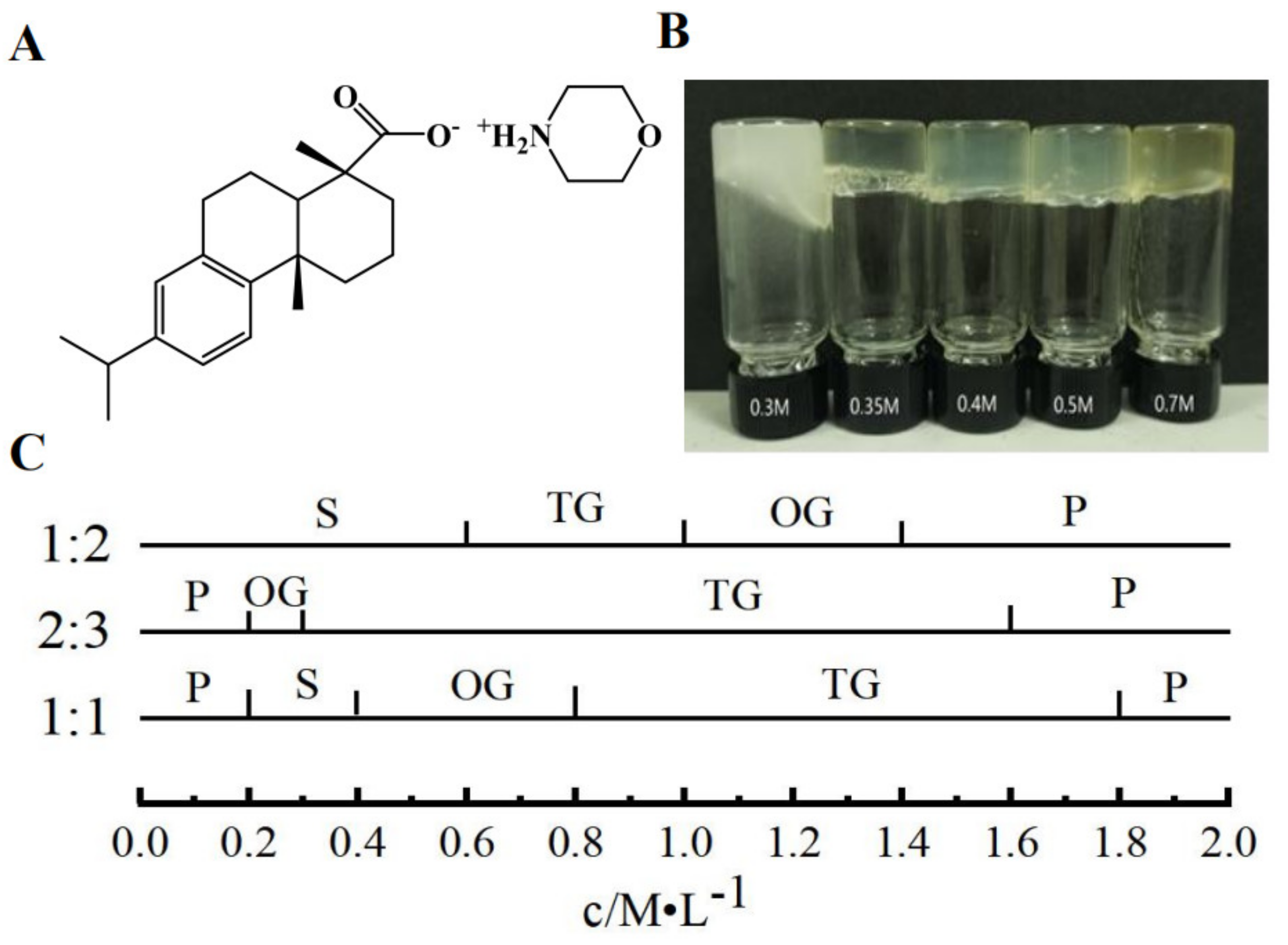
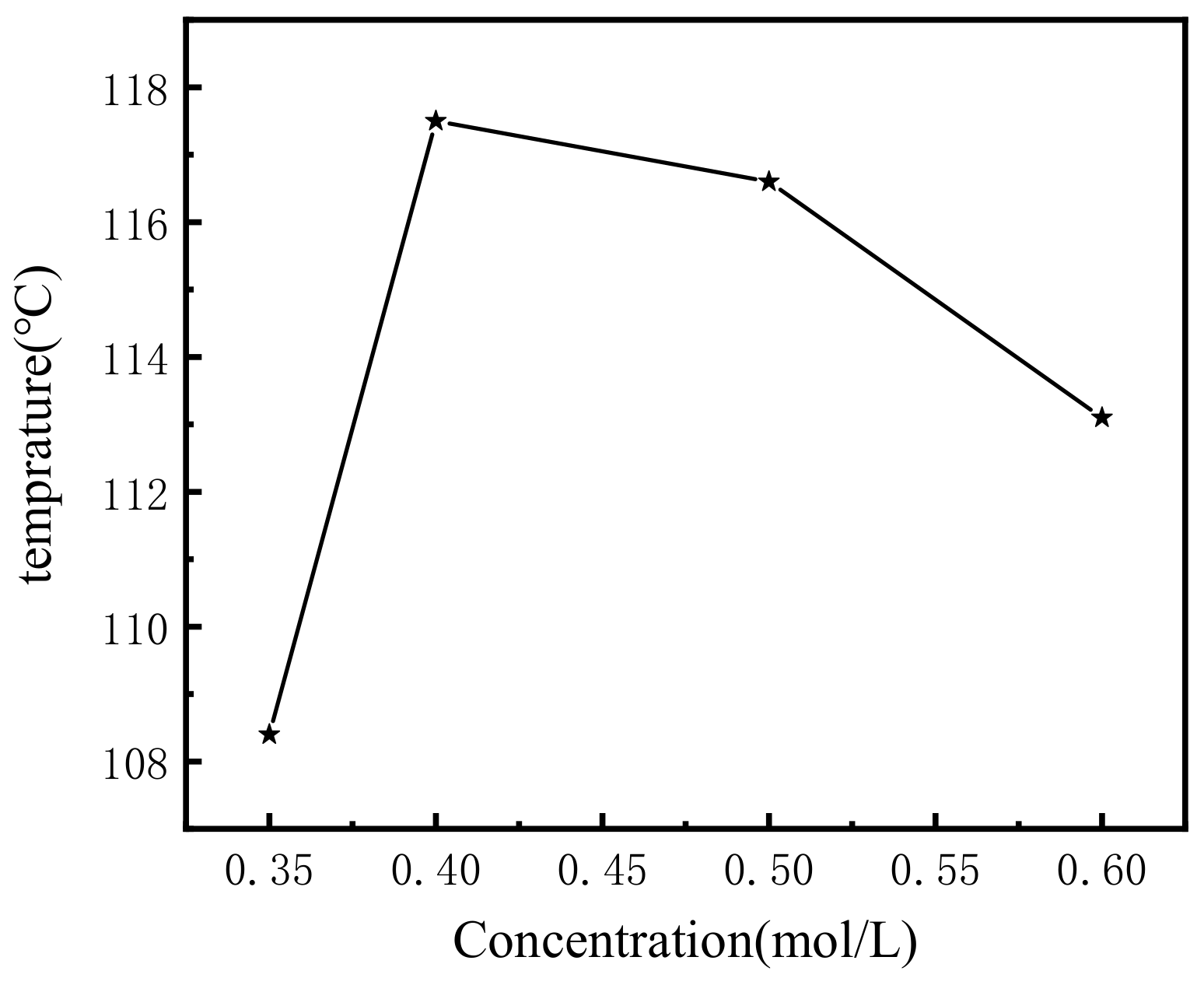
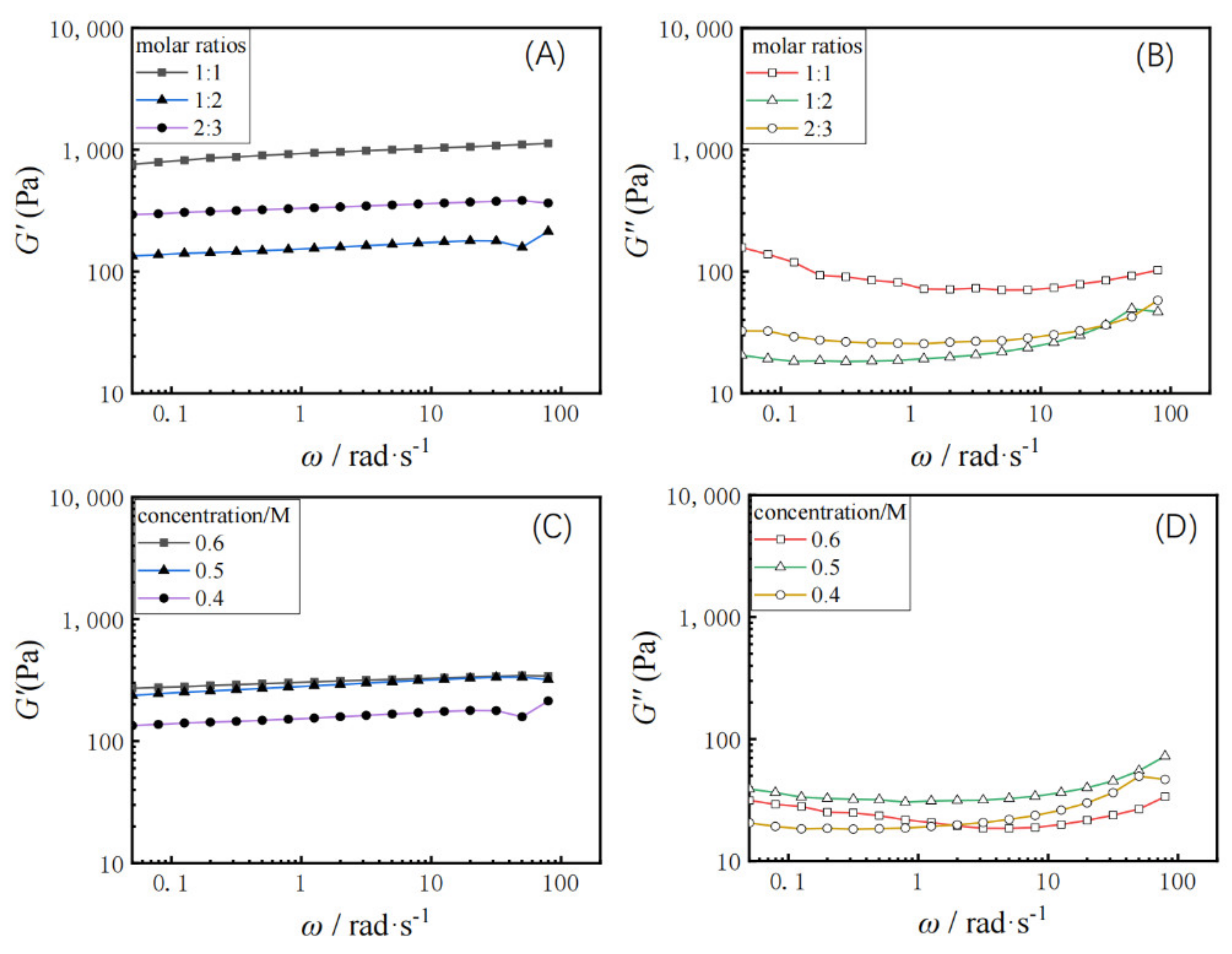
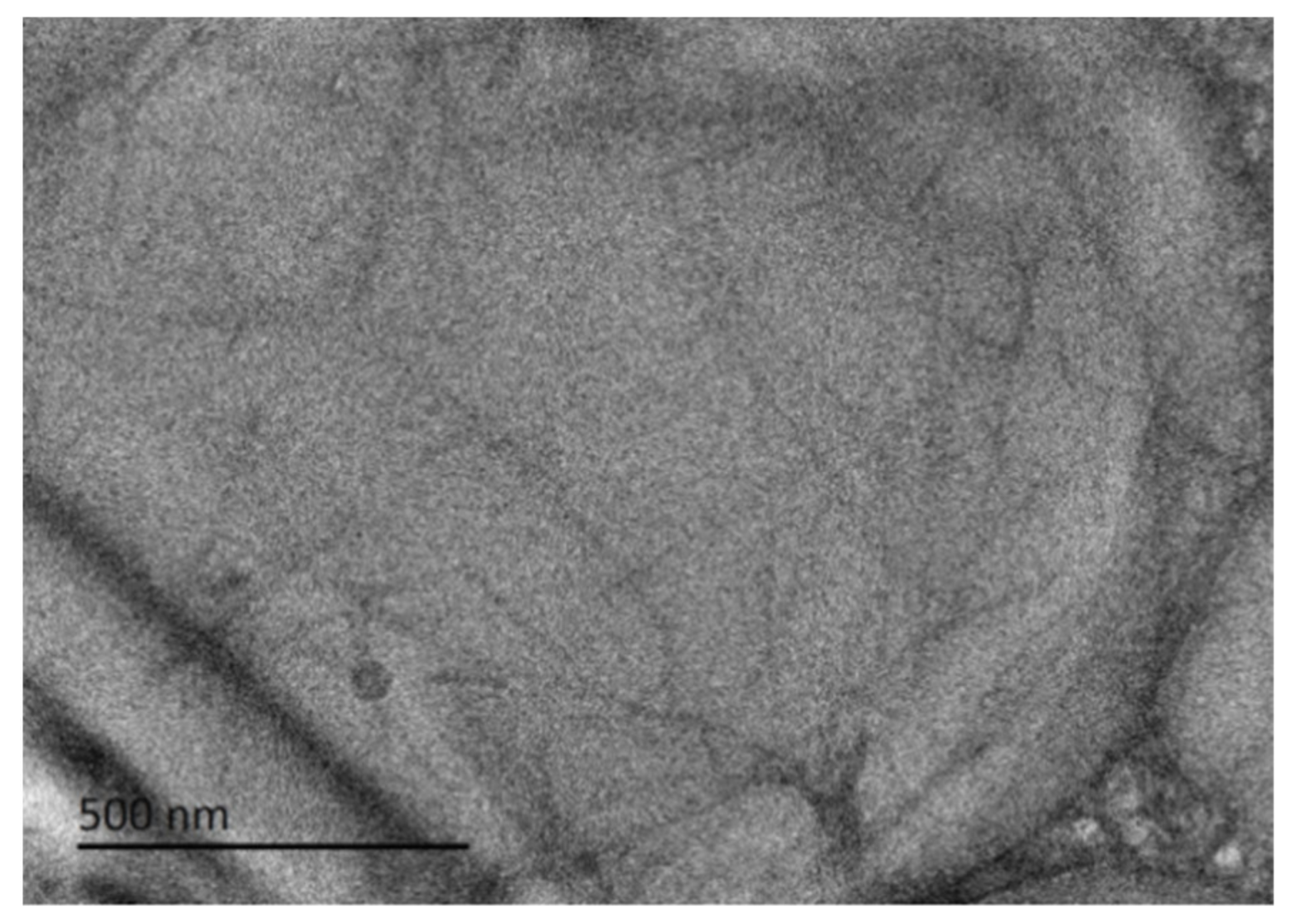
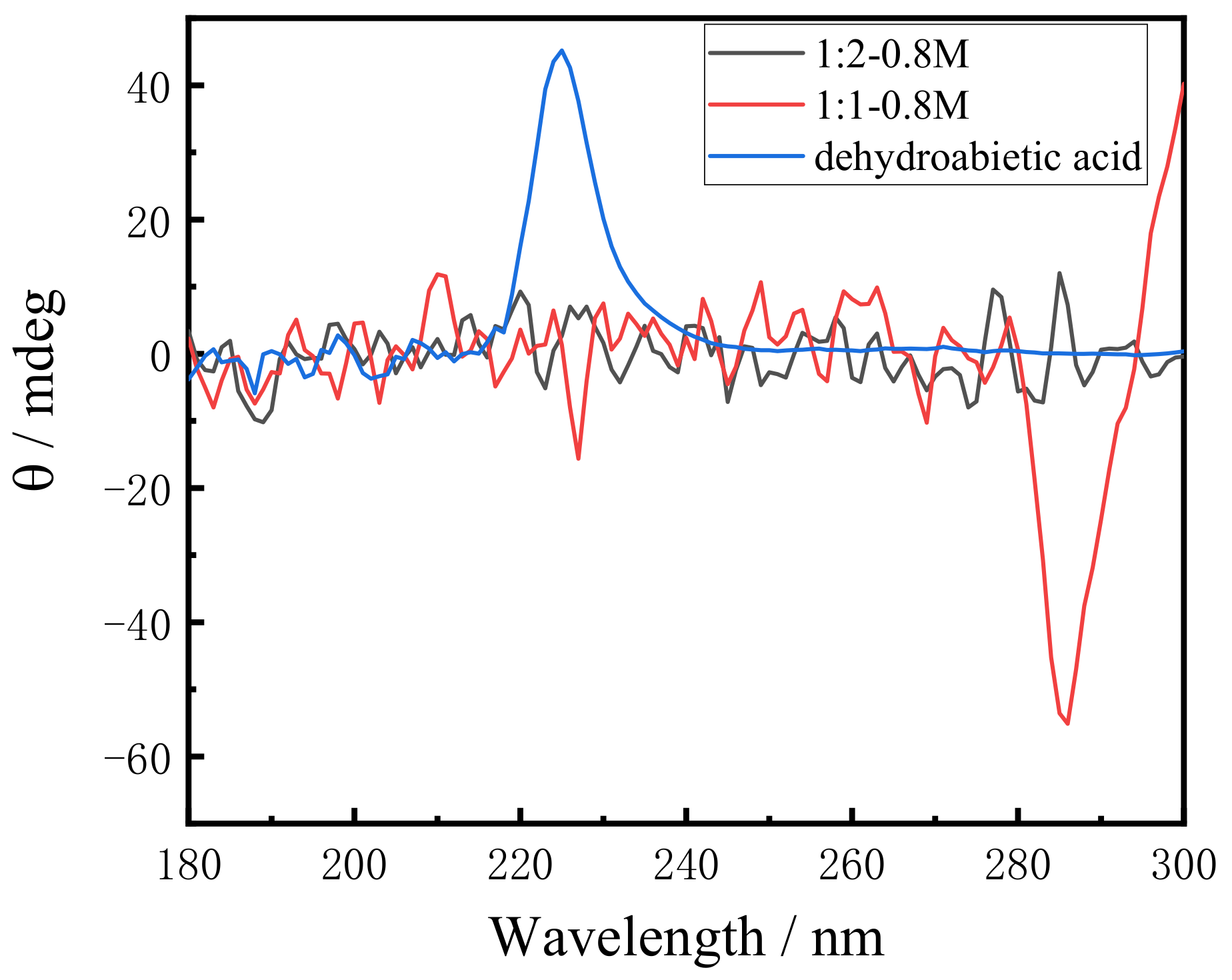
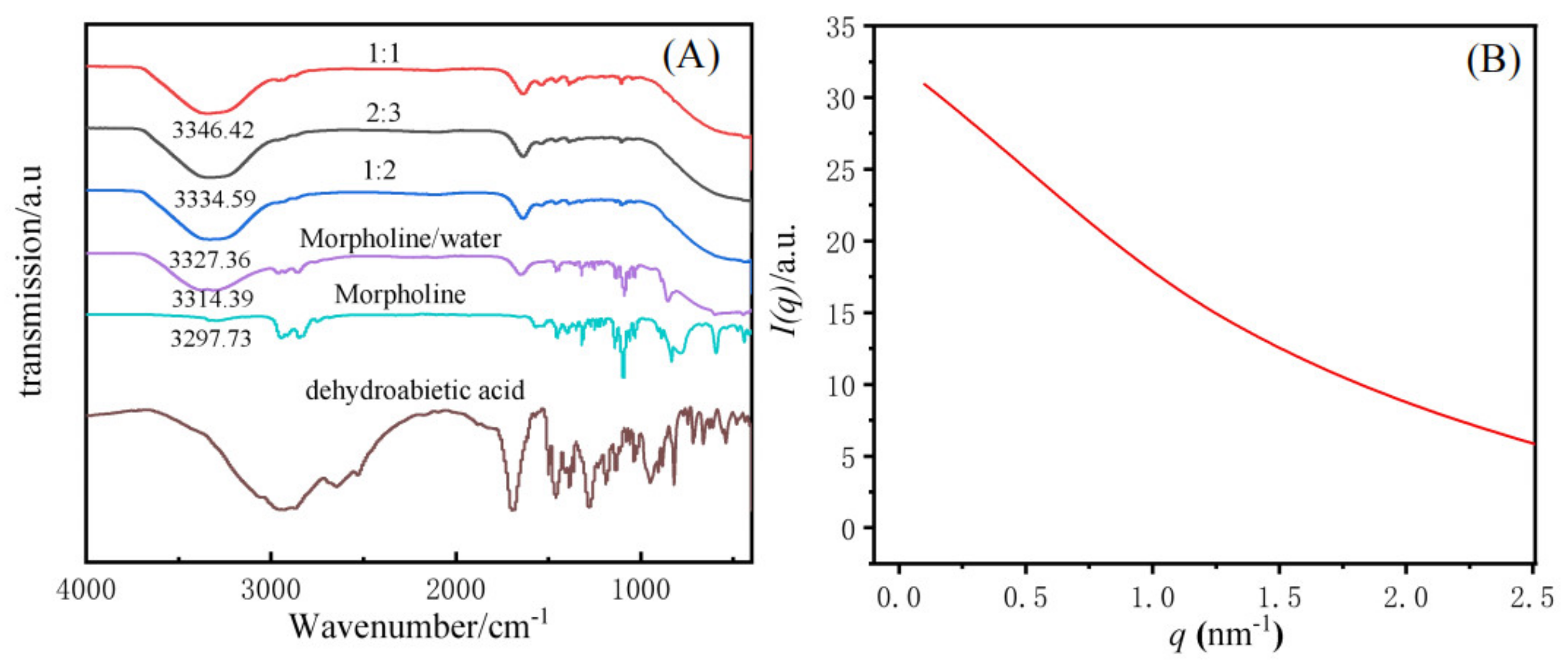
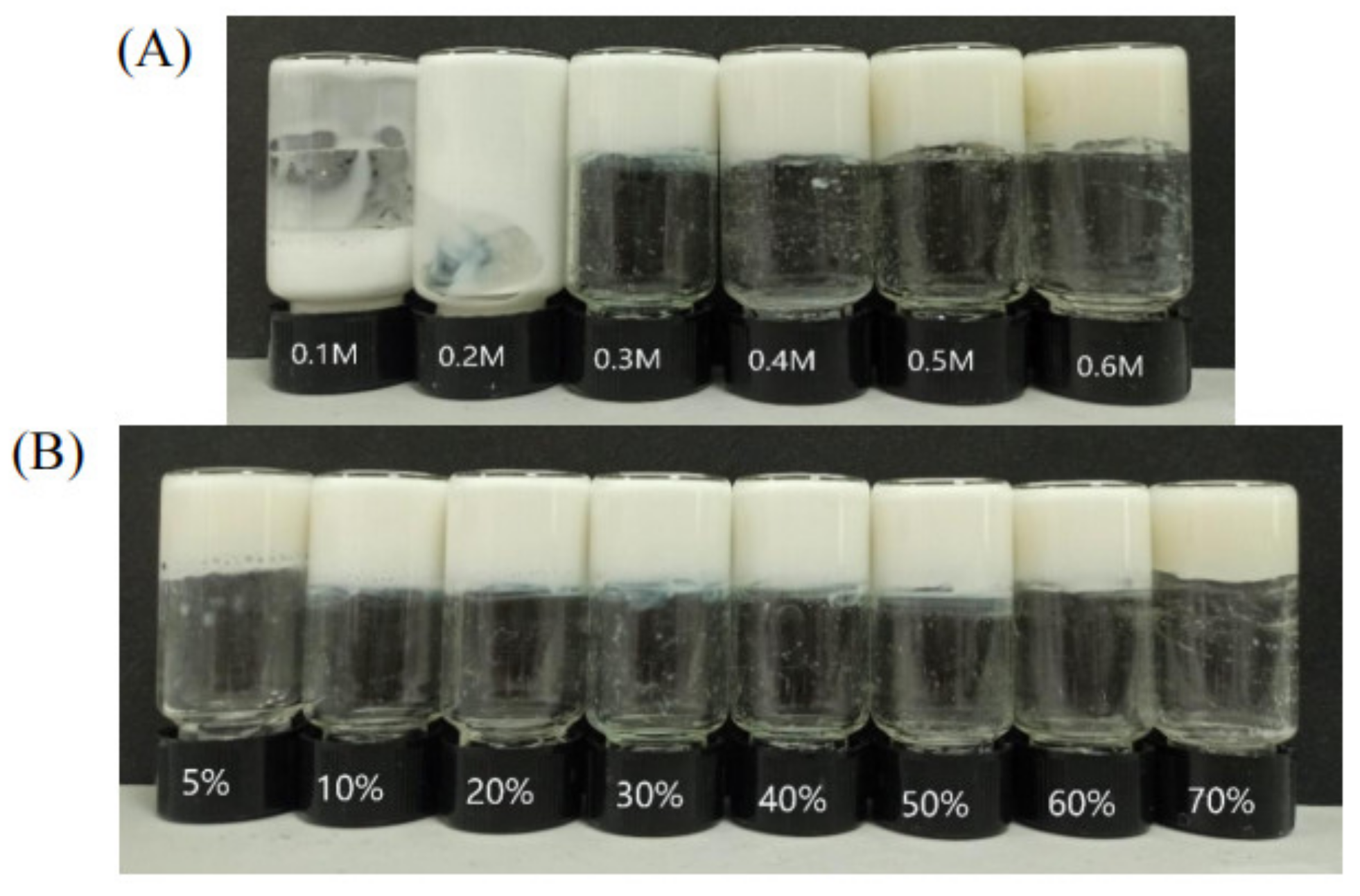


Publisher’s Note: MDPI stays neutral with regard to jurisdictional claims in published maps and institutional affiliations. |
© 2021 by the authors. Licensee MDPI, Basel, Switzerland. This article is an open access article distributed under the terms and conditions of the Creative Commons Attribution (CC BY) license (https://creativecommons.org/licenses/by/4.0/).
Share and Cite
Lin, C.; Li, Y.; Tang, W.; Zhou, S.; Rao, X. Facile Construction of Bio-Based Supramolecular Hydrogels from Dehydroabietic Acid with a Tricyclic Hydrophenanthrene Skeleton and Stabilized Gel Emulsions. Molecules 2021, 26, 6526. https://doi.org/10.3390/molecules26216526
Lin C, Li Y, Tang W, Zhou S, Rao X. Facile Construction of Bio-Based Supramolecular Hydrogels from Dehydroabietic Acid with a Tricyclic Hydrophenanthrene Skeleton and Stabilized Gel Emulsions. Molecules. 2021; 26(21):6526. https://doi.org/10.3390/molecules26216526
Chicago/Turabian StyleLin, Caiyun, Yuying Li, Weishan Tang, Shufeng Zhou, and Xiaoping Rao. 2021. "Facile Construction of Bio-Based Supramolecular Hydrogels from Dehydroabietic Acid with a Tricyclic Hydrophenanthrene Skeleton and Stabilized Gel Emulsions" Molecules 26, no. 21: 6526. https://doi.org/10.3390/molecules26216526
APA StyleLin, C., Li, Y., Tang, W., Zhou, S., & Rao, X. (2021). Facile Construction of Bio-Based Supramolecular Hydrogels from Dehydroabietic Acid with a Tricyclic Hydrophenanthrene Skeleton and Stabilized Gel Emulsions. Molecules, 26(21), 6526. https://doi.org/10.3390/molecules26216526






